Do you love shooting stars? Wondering if there is a meteor shower tonight? Here are some of the best-known meteor showers, when, and where to see them—followed by more details about each. Plus, meteor shower watching tips. Good luck—and be sure to share your experiences and any photos in the comments section!
Seeing a meteor shower is one of the best perks of stargazing! You’re outside on a beautiful clear night, the stars are shining, you’re finding the constellations, and maybe even a planet or two. Then, “ooh” you see a shooting star blaze across the sky. Then, “aah” another one. And another!
You can go outside on any clear night and occasionally see a stray shooting star or two. But on many nights, you might not see any meteors for hours. Welcome to the fickle world of observing meteor showers.
Why are meteor showers so hard to predict? What causes them and why do some years dazzle while others fizzle? Here are my tips for seeing the best meteor showers of the year: which ones you can skip, and which ones are worth staying up late to see.
Jump to meteor shower watching tips
Meteor Shower Season
Meteor shower season begins in the spring and ends in the winter. When gardens and wildlife wake up from winter’s sleep it’s as if the shooting stars do too—decorating the night with bright streaks! From the Lyrids to the Perseids, Geminids to the Quadrantids, each meteor shower has its own special charm.
As the year goes on, these showers come and go, their brightness increasing and decreasing. By the time January comes, the sky quiets down, and the major meteor showers seem to take a break.
This cycle is reminiscent of the old Roman calendar and the zodiac signs, which begin in spring. Just as the Earth starts fresh with the spring equinox, so does the cycle of shooting stars, mirroring the cycle of life through the four seasons.
Speaking of four seasons … Find out what the weather will be like all year!
When Is The Next Meteor Shower?
This chart lists the most well-known meteor showers as well as the Farmers’ Almanac recommendations for your best chances of catching a shooting star, based on predictions of each shower’s period of peak activity.
|
Meteor Shower Calendar 2025-2026
|
||||
|---|---|---|---|---|
| Meteor Shower Name | Dates of Peak Activity | Hourly Rate | Direction and Time* | Speed |
| Lyrids | Apr 22-23 | 10-20 | East and overhead 2 to 4 am | Swift streaks |
| Eta Aquariids | May 5-6 | 5-20 | Southeast 2 to 4 am | Very swift, long paths |
| Delta Aquariids | July 28-30 | 15-25 | South 1 to 3 am | Slow, long paths |
| Perseids | Aug 11-13 | 45-90 | Northeast 1 to 3 am | Very swift, rich display |
| Orionids | Oct 21-22 | 15-25 | South 2 to 4 am | Swift streaks |
| South Taurids | Nov 4-5 | 10-20 | South 1 to 3 am | Very slow, bright |
| North Taurids | Nov 12-14 | 10-20 | South 12 to 2 am | Slow fireballs |
| Leonids | Nov 17-18 | 10-15 | Southeast 4 to 5 am | Very swift |
| Geminids | Dec 13-14 | 60-120 | Overhead 2 to 5 am | Medium |
| Ursids | Dec 22-23 | 5-15 | North all night | Medium |
| Quadrantids | Jan 2-4 | 60-120 | Northeast 4 to 6 am | Medium |
February and March usually don’t have big meteor showers like the ones in other months. But you might still spot meteors on any night. It only takes clear skies and a little bit of luck! These meteors, which people often call “random” meteors, don’t belong to any specific meteor shower and may be seen all year-round.
Speaking of luck … Why is wishing on a shooting star good luck? Find out!
Meteor Shower Calendar 2025-2026: Details
Here are more details about each of the meteor showers listed above, including your probability of seeing shooting stars based on the phase of the Moon during each period of peak activity. We highly recommend: The Lyrids (April), Orionids (October), and Geminids (December).
⭐ April 23-23: Lyrids
The Lyrids peak in the late hours of April 22 and into the early hours of April 23, 2025. These shooting stars are typically fickle performers and can disappoint audiences. But I am watching for them this year! What makes them more appealing is that a slim crescent Moon will not block out the fainter shooting stars. And frankly, I’m much more looking forward to staying up late on a mid-spring night versus the other showers occurring November-January.
RELATED PRODUCT: Water-resistant Picnic Blanket (perfect for stargazing!)
To see the Lyrids, face east starting at midnight and look for meteors radiating away from the constellation Lyra the Harp. Between 2-5am you can turn more to the southern sky. (But by that time shooting stars may appear from any direction.) Originating from the comet C/1861 G1 Thatcher, the Lyrids can produce a respectable ten meteors per hour.
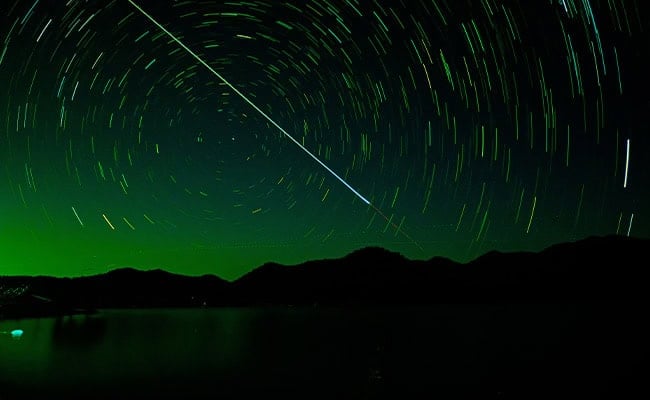
😡 August 12-13: Perseids
The Perseids are the meteor shower of summer, peaking each year on August 12 or 13. You want to generally face in the direction of the constellation Perseus, which rises in the northeastern sky at midnight and shifts high in the south later at night, but meteors can streak from any direction at any time between midnight and dawn. Be patient and vigilant.
2025 will most likely be a down year for spotting Perseids. The nearly full Moon will light up the night so much that only a handful of the brightest shooting stars that week will be visible. But the Perseids should be back in 2026 when they occur not only at New Moon, but also overlapping with the next Total Solar Eclipse.
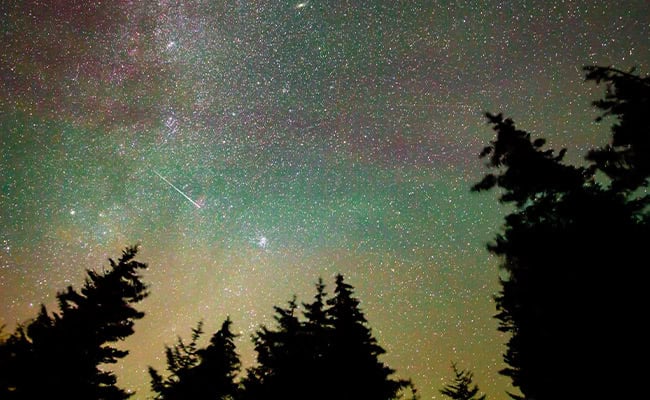
⭐ October 21-22: Orionids
The most famous comet in the sky, Halley’s Comet, is responsible for the Orionid meteor shower. The Orionids peak every year around October 21. Although you can’t see Halley’s Comet in all its glory until it passes near Earth again in 2061, you can still see its remnants from previous flybys in the sky every year.
Face the constellation Orion on October 21 or 22 between 1 a.m. and 5 a.m. to see the maximum number of Orionids. Unlike the Perseids, the Moon will largely be out of the way so this could be one of the strongest meteor showers of 2025.
November 17-18: Leonids
The Leonids produce reliably good meteor showers every November 17 or 18. To find them, lie back and search the skies around the constellation Leo as it comes up in the eastern sky after midnight and slowly arcs to the south later at night. If you watch all night until the break of dawn, you may see dozens of meteors per hour.
RELATED: The 10 Brightest Stars
The Leonids in 2001 sparked the last great meteor storm, when observers around the world witnessed several shooting stars per minute. Will that happen again this year? Doubtful, but I’d still put the Leonids 2025 on the watch list.
⭐ December 13-14: Geminids
One annual meteor shower that has become increasingly visible in the twenty-first century is the Geminids. Every December 13 or 14, scan the sky around the constellation Gemini between 2 a.m. and 5 a.m. to see the peak of this unusual meteor shower.
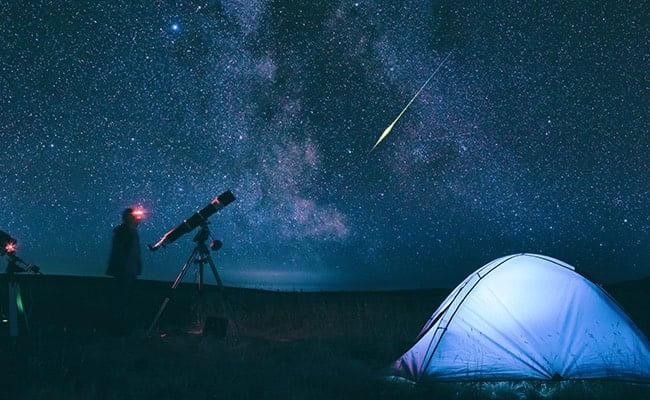
The Geminids are not cometary in origin—they actually come from an asteroid called 3200 Phaethon, a rocky and icy body circling the Sun. As it regularly flies close to Earth, 3200 Phaethon leaves bits of rock and ice behind. Every December, Earth flies through these asteroid parts and stargazers are treated to a solid meteor shower.
Aquariids, Taurids, Ursids, and Quadrantids …
Historically the Aquariids, Taurids, and Ursids have been lesser meteor showers. During their peak nights, unless you are patient or lucky you might not see more than a few shooting stars per hour.
Meteor Shower Origins
It starts with a comet. When a comet passes near the Sun, it sheds icy material to form a long tail. Tail particles are tiny pieces of ice and dust that make a debris field along the comet’s orbit. Earth slams into this cometary debris on a yearly basis, and the result is a predictable schedule of meteor showers.
The most steadily performing annual meteor showers are the Perseids, Orionids, Leonids, and Geminids. Meteor showers get their names from the constellation from which the shooting stars seem to radiate. The meteors don’t actually fall from the stars in Perseus, Orion, Leo, and Gemini: They just appear to do that. They actually ignite in Earth’s atmosphere, about forty miles up.
General and Important Viewing Tips
The best times to view meteor showers are generally between 2 a.m. and 5 a.m. You can see some early shooting stars around midnight, but the later you stay up the better. Don’t use telescopes or binoculars: Your naked eye is all you need. Take in as much of the sky as possible to catch as many stray streaks as you can.
Get away from the lights of the city and find a dark sky location where you can detect even the faintest meteors. Avoid meteor showers that peak during a Full Moon, because the moonlight will wash out all but the brightest meteors. And keep your expectations low. While some astronomers predict that you’ll see dozens to hundreds of meteors per hour, it is more realistic to expect 10–20 per hour.
Be patient. You might go 5, 10, or even 20 minutes between shooting stars. My greatest advice is to go into the experience with these goals: being outside, staying up late with friends and family, and seeing the stars and constellations. If you see some shooting stars, hey, what a cool bonus!
Catch Shooting Stars Tonight With Our Tips!
The best way to watch for meteors is to check your weather forecast, find a place with a clear view of the sky, and arrange comfortable deck chairs with pillows and blankets. Be sure to wear warm clothing—even in summer—as the nights and earlier morning can be colder than you might think!
Another factor to consider is bright moonlight, which can considerably cut into the potential number of meteors that might be seen. If a gibbous or full Moon is present during your meteor watch, its bright light will make seeing meteors difficult.
For a better experience, get away from city lights, give your eyes time to get used to the dark, and then just look up. Recline and relax with these ten essential tips, followed by suggestions for each season.
10 Essential Meteor Shower Tips
- Check the Weather: Before heading out, make sure to check the weather forecast for your location. Clear skies are essential for optimal viewing. Farmers Almanac Extended Weather Forecast
- Find a Dark Location: Choose a spot away from city lights to minimize light pollution and maximize visibility. Dark skies provide the best backdrop for meteor watching.
- Arrive Early and Be Patient: Give yourself plenty of time to get settled and let your eyes adjust to the darkness. Meteor showers can be unpredictable, so patience is key.
- Bring Comfortable Seating: Bring along a comfortable chair, blanket, or sleeping bag to sit or lie down on while you watch. Meteor showers can last for hours, so comfort is important.
- Dress Appropriately: Even in warmer months, nighttime temperatures can drop significantly. Dress in layers and wear warm clothing to stay comfortable during your viewing session.
- Avoid Bright Lights: Minimize the use of flashlights and electronic devices, as they can disrupt your night vision and make it harder to see meteors. If you need light, use a red flashlight instead.
- Look Towards the Radiant: Each meteor showers appears to radiate from a specific point in the sky known as the radiant. While some stargazers claim to see more shooting stars by looking directly towards the radiant, you may also have luck looking from your peripheral vision. As a general rule, the more sky you can see the better your chances are!
- Bring a Star Chart or Mobile App: Bring along a star chart or use a mobile app to help identify meteor shower radiants and constellations (mentioned in parenthesis after each meteor shower name above).
- Stay Hydrated and Snack: Bring along water and snacks to stay hydrated and energized during your meteor shower viewing. It’s easy to lose track of time while gazing at the sky.
- Enjoy the Moment: Take time to appreciate the beauty and wonder of the night sky. Meteor showers are rare and magical events, so relax, enjoy the experience, and make memories that will last a lifetime.
Spring Stargazing Tips
- Be Prepared for Variable Weather: Spring weather can be unpredictable, so check forecasts and be prepared for sudden changes in temperature and precipitation.
- Watch for Pollen: Springtime brings pollen and allergens that can irritate sensitive individuals. Consider taking allergy medication if needed.
- Take Advantage of Longer Days: With longer daylight hours in spring, plan your stargazing sessions for later in the evening to ensure darker skies.
Summer Stargazing Tips
- Stay Hydrated: Summer nights can still be warm, so be sure to stay hydrated by bringing plenty of water with you.
- Plan for Humidity: Summer humidity can lead to hazy skies and reduced visibility. Choose locations away from urban areas and sources of light pollution for clearer views.
- Use Bug Spray: Insects are often more active during summer evenings. Apply bug spray to deter mosquitoes and other pests.
- Consider Outdoor Fans: If you’re stargazing from your backyard or patio, consider using outdoor fans to keep cool and discourage insects.
Fall Stargazing Tips
- Watch for Clear Nights: Fall often brings clear, crisp nights ideal for stargazing. Keep an eye on weather forecasts and plan your stargazing sessions on nights with minimal cloud cover.
- Dress in Layers: Temperatures can vary greatly during fall evenings. Wear layers that you can easily add or remove as the night progresses.
- Bring Insect Repellent: Fall evenings may still have lingering mosquitoes and other insects. Apply insect repellent to prevent discomfort and distractions while stargazing.
Winter Stargazing Tips
- Bundle Up: Winter nights are cold, so dress warmly in layers and bring along hand and foot warmers to stay comfortable.
- Check for Icy Conditions: Watch out for icy patches, especially in areas with snow or freezing temperatures. Use sturdy footwear with good traction to prevent slips and falls.
- Protect Your Equipment: Cold temperatures can affect the performance of telescopes, binoculars, and cameras. Allow your equipment to acclimate to the outdoor temperature gradually to prevent fogging and condensation. Consider using dew shields or lens heaters to minimize moisture buildup.
- Take Breaks Indoors: If you start feeling too cold, take periodic breaks indoors to warm up before returning to stargazing.
- Minimize Exposed Skin: Cover up exposed skin to prevent frostbite and windburn. Apply moisturizer to protect against dryness and chapping.
- Check the Weather Forecast: Winter weather can be unpredictable, so be sure to check the forecast for any potential clouds or storms that could obstruct your view.
- Bundle Up: Winter nights can be bitterly cold, especially in open areas away from city lights. Dress in layers, including thermal undergarments, a warm coat, gloves, hat, and thick socks to stay comfortable and ward off the chill.
- Use Hand and Foot Warmers: Consider bringing along hand and foot warmers to keep extremities warm during prolonged periods of stargazing. Place them inside your gloves, pockets, or boots for added warmth.
- Bring Hot Beverages: Pack a thermos of hot cocoa, tea, or coffee to enjoy during your stargazing session. Not only will it help keep you warm, but it adds to the cozy winter experience.
Games To Pass The Time!
Here are some verbal games that are great for passing the time while stargazing with friends and family:
- Constellation Riddles: One person thinks of a constellation and gives clues about its shape, position in the sky, or mythological origin. Others try to guess the constellation based on the clues provided.
- Starry Sky Trivia: Prepare some astronomy trivia questions in advance or use a stargazing app to find interesting facts about celestial objects. Take turns asking questions and see who can answer the most correctly.
- Night Sky Storytelling: Build a collaborative story inspired by the stars. Start with one person beginning a story involving a constellation or celestial object visible in the sky. Then, each person adds a sentence or two to continue the story, incorporating elements from the night sky.
- Star Catalog Challenge: Challenge each other to identify as many constellations and stars as possible within a certain time limit. Use star charts or stargazing apps to help with identification.
- Astrological Guessing Game: One person describes the characteristics or traits associated with a particular zodiac sign, and others try to guess which sign it is. This game can lead to discussions about astrology and its connection to the night sky.
- Celestial Alphabet Game: Starting with the letter ‘A’, take turns naming celestial objects, such as stars, constellations, planets, or galaxies, that begin with each letter of the alphabet. See how far you can get before reaching ‘Z’!
These games can add an element of fun and engagement to your stargazing experience, encouraging interaction and learning while enjoying the wonders of the night sky with friends.
Suggestions For A Stargazing Picnic!
A nighttime picnic can be a delightful way to enjoy the meteor shower while lying back on your Stargazing Picnic Blanket and indulging in delicious food and drinks. Here are some suggestions for a memorable nighttime picnic:
- Easy-to-Eat Finger Foods: Opt for a selection of easy-to-eat finger foods that are convenient to enjoy without utensils. Consider items like cheese and crackers, sliced fruits (such as grapes, apples, and berries), nuts, olives, and bite-sized sandwiches or wraps.
- Charcuterie Board: Create a charcuterie board with an assortment of cured meats, cheeses, bread or crackers, nuts, dried fruits, and spreads. Arrange the ingredients on a wooden board or platter for an elegant and visually appealing spread.
- Warm Beverages: Bring along thermoses filled with hot chocolate, mulled cider, or herbal tea to keep you warm and cozy during the chilly night. Consider adding a splash of cinnamon or a twist of citrus for extra flavor.
- Sweet Treats: Treat yourself to some sweet treats for dessert. Pack cookies, brownies, chocolate truffles, or fruit tarts to satisfy your sweet tooth while stargazing.
- Portable Snacks: Choose snacks that are easy to transport and enjoy outdoors. Pack individual servings of popcorn, trail mix, granola bars, or pretzels for a quick and convenient snack option.
- Picnic Blanket and Cushions: Bring along a comfortable picnic blanket or outdoor cushions to sit on while enjoying your meal. Choose blankets made from warm and cozy materials to keep you comfortable during the nighttime picnic.
- Stargazing Accessories: Don’t forget to bring stargazing accessories such as binoculars, telescopes, or star maps to enhance your celestial viewing experience. Consider downloading stargazing apps on your smartphone for an interactive guide to the night sky.
- Candlelight Ambiance: Create a romantic ambiance with flickering candlelight or battery-operated LED candles. Place candles in glass jars or lanterns to provide soft, ambient lighting while adding a touch of warmth to the picnic setting.
- Blankets and Layers: Since nighttime temperatures can be cooler, be sure to dress warmly and bring along extra blankets or layers to stay comfortable throughout the picnic. Consider wearing hats, scarves, and gloves to keep warm while stargazing.
- Waste-Free Picnicware: Use reusable picnicware such as plates, cups, utensils, and napkins to minimize waste and reduce environmental impact. Bring along a small garbage bag to collect any trash and dispose of it properly after the picnic.
With these suggestions, you can create a magical nighttime picnic experience that combines delicious food, cozy ambiance, and breathtaking views of the night sky during the meteor shower. Enjoy the celestial spectacle with loved ones and make lasting memories under the stars.
Join The Discussion
Did you see a shooting star from any meteor showers tonight? If so, which one?
What is one fond memory you have of catching a shooting star?
Share your experience with your community here in the comments below!

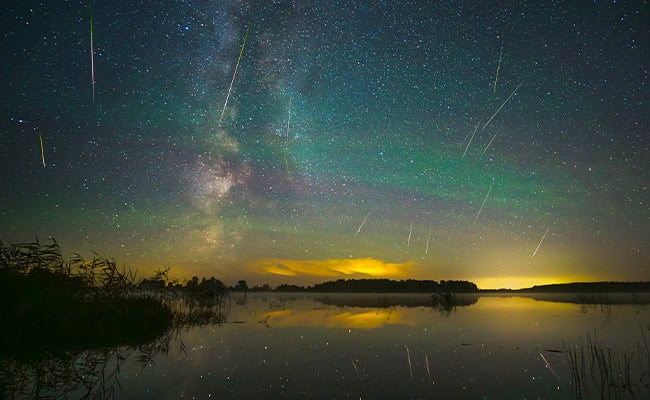
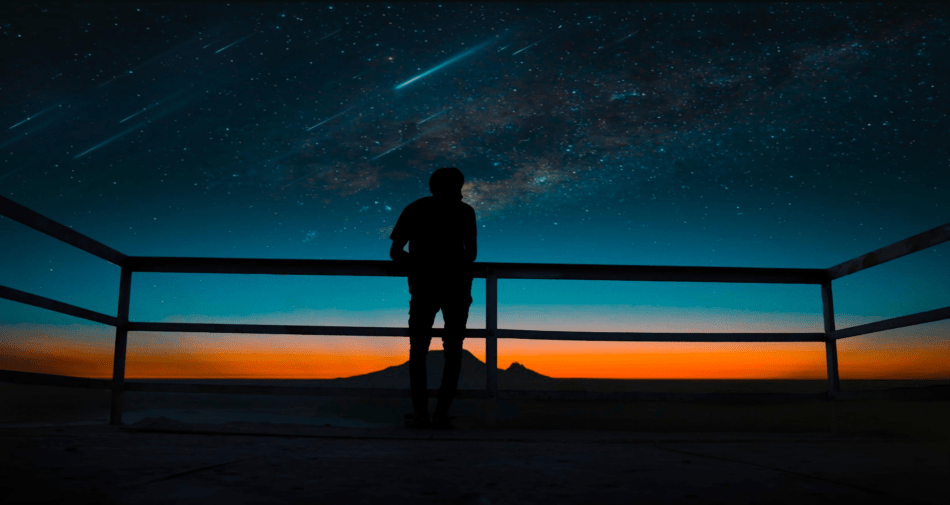
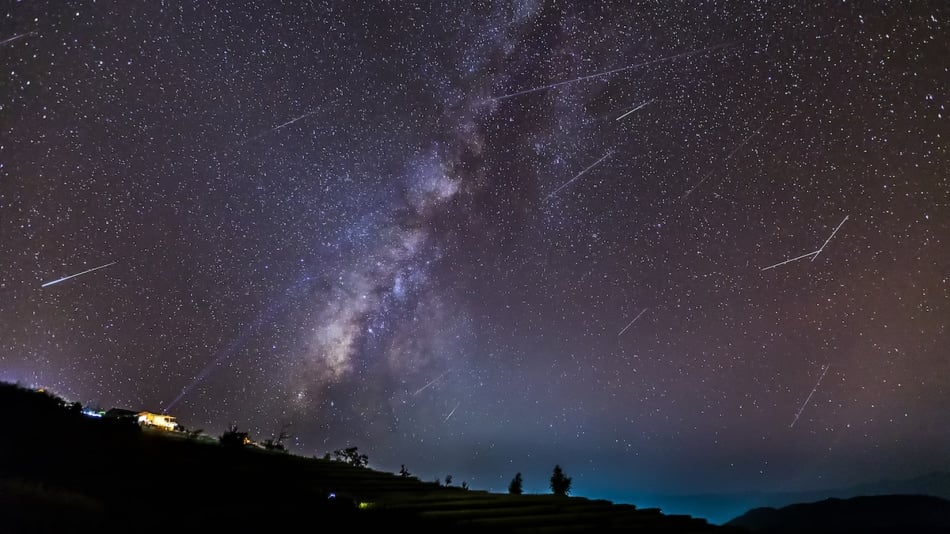
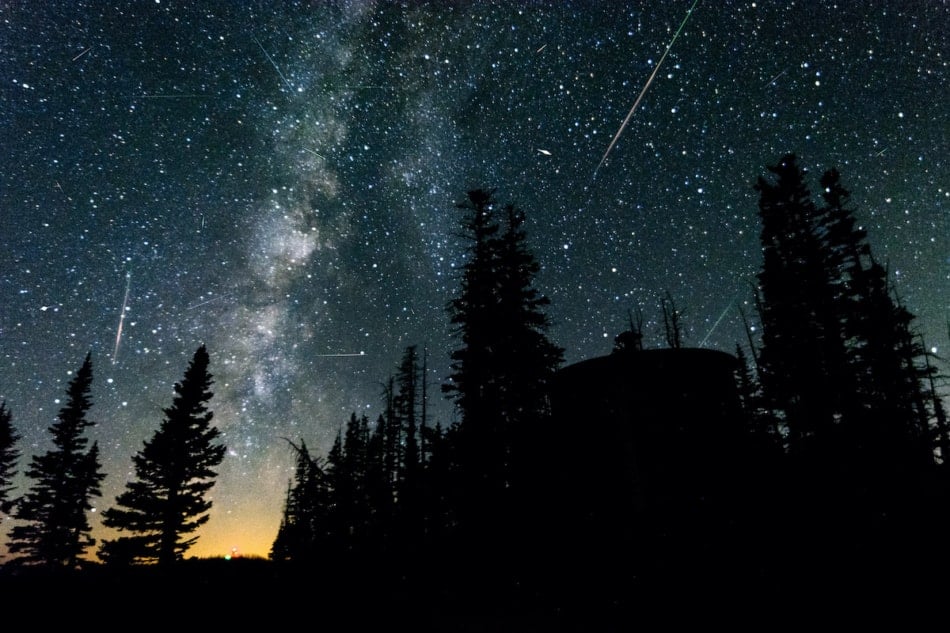
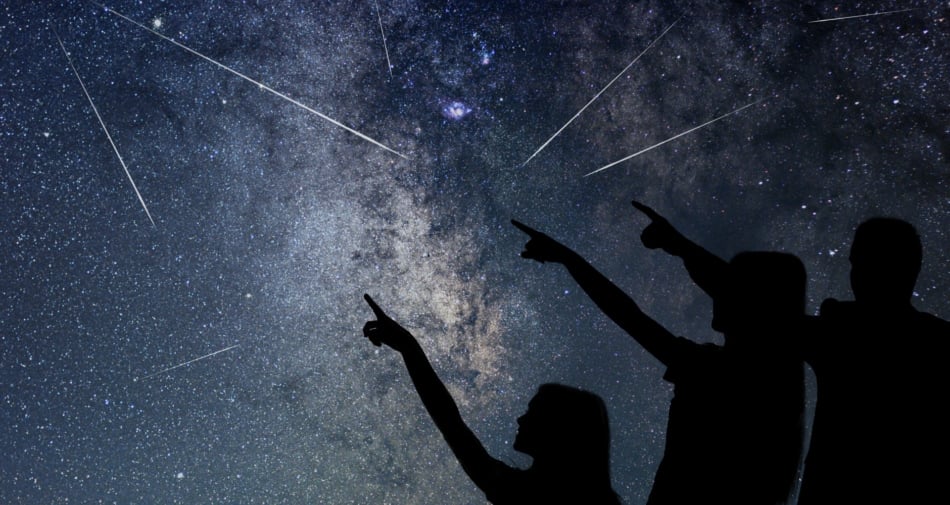



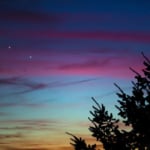
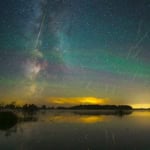
I was sitting out back with my dog, Lu, watching the Lyrids Meteor Shower (4-23-2025) and saw the most beautiful and bright shooting star! It is a perfect, peaceful night for it.
Congratulations Sara (and Lu)! Thanks for sharing your experience. It gives other readers hope! We hope your wish comes true. Oh, and you may be interested in this article: https://www.farmersalmanac.com/shooting-stars-and-good-luck
When the movie “The Passion of the Christ” first came out I was in college, and right after seeing the movie, which left us mostly silent as we contemplated and meditated on what we had just watched, we headed back to the campus. On the way, straight out the front windshield, we saw a shooting star. I have no idea if it was part of a meteor shower. It would have been around 10pm or so Eastern time. It was so neat to have seen that right after such a moving and emotionally rocking experience. Sort of a cap to the evening. It sure made it unforgettable.
Meteor showers do and have always scared me. They just look fierce to me. I refuse to look at them.
Sorry to hear that, D. Do you prefer full Moons? If you tell us some things that you like, we would love to offer some alternative suggestions for you. Best wishes, FA Team